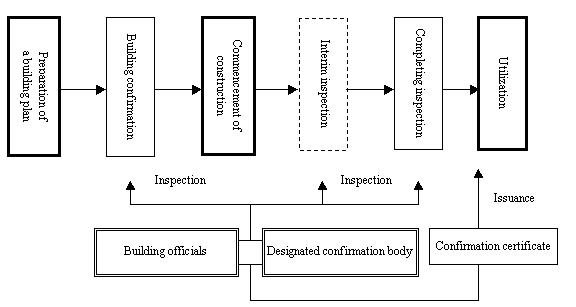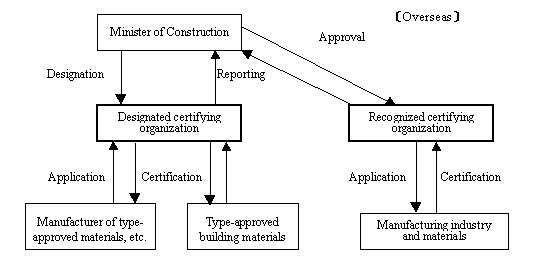The objective of this law is to establish minimum standards regarding the site, structure, facilities, and use of buildings in order to protect life, health, and property of the nation, and thereby to contribute to promoting public welfare.
(2) OUTLINE OF THE LAW AND SYSTEM
As for technical standards for buildings, the Law prescribes "building code" and "zoning code".
The building codes are technical standards for all buildings in order to ensure building safety with regards to structural strength, fire prevention devices, sanitation, etc (Chapter II, Articles 19 to 41). The zoning codes are technical standards to ensure rational and safe utilization of land and to improve environment. Such utilization is required by towns and cities where buildings are concentrated (Chapter III, Articles 41-2 to 68-26).
(3) CABINET ORDER AND MINISTRIAL ORDINANCES
Enforcement Order of the Building Standards Law
Enforcement Regulations of the Building Standards Law
(4) OUTLINE OF THE CONTROL
1) Items Covered
Building construction and buildings
2) Outline of Specifications, Standards and Inspections, etc.
i. Content of the Control
(a) Structural Method of Construction
Technical standards to be observed are established for each structure classification generally used in Japan such as wooden construction, steel frame construction, or reinforced concrete construction, etc.. Moreover, the safety of buildings the size of which exceeds a fixed limit must be ensured through structural calculations (Article 20). Performance code has been replacing the original description code since 1999, allowing for use various materials, equipment, and structural methods, including wood-frame construction, as long as the building satisfies the performance criteria. In particular, the way is now open for foreign materials with no dedicated set of specifications, due to no precedent of usage in Japan, and can now be imported provided that they satisfy the relevant performance specifications.
(b) Fireproofing properties
In order to ensure such as the fireproof properties of structures, the Law, etc. provides standards based on the scale of the structure, its purpose, the types of framework used in parts of the structure (fireproof construction, fire preventive construction, etc.) and materials (non combustible materials, quasi-noncombustible materials, etc.) and so on. Moreover, testing methods to verify such as the fireproof properties of each type of material are prescribed. Only materials that have cleared the related tests and have been designated by the Minister of Land, Infrastructure and Transport may be used as fire preventive materials, etc.
(c) Restrictions on construction in zones for use for special purposes
In zones where use of the area is determined by urban planning (first class exclusively residential zone, second class exclusively residential zone, residential zone, neighborhood commercial zone, commercial zone, quasi-industrial zone, industrial zone, and exclusively industrial zone), construction of certain structures (such as factories, warehouses and theaters in exclusively residential zones) is prohibited according to the purpose of the said special use zone (Article 48).
However it is prescribed that the special administrative agency (such as prefectural governor responsible) may give permission for constructing buildings where the above restrictions prohibit construction, by recognizing that no danger exists of damage to the environment, inconvenience to commerce and industries, after obtaining an agreement from the Building Review Council, and following a public hearing with the parties concerned.
ii. Outline of Testing and Certification System
(a) Building Confirmation and Inspections
The building officials of a local government or a "designated confirmation bodies" conducts building confirmation and inspections.
Confirmation is comprised of a building confirmation in the pre-construction stage and a completed inspection, while for some buildings an interim inspection is also required (Art. 6, 6-2). After completion of these inspections, if conformity with building standards is recognized, a building officials or a "designated confirmation bodies" issue a "confirmation certificate".
An "interim inspection" concerns with buildings having certain structures and/or purposes, and is conducted on specific construction processes designated by the local government body. Therefore, multiple dwelling houses, multi-storied buildings and public architecture, etc. are mainly subject to this inspection(Article 7-3).
(Flowchart of building confirmation)

(Note) The building official and confirmation inspector of a designated confirmation and inspection organization are "qualified persons on judgment of the conformity with building standards" registered by the Minister of Land, Infrastructure and Transport.
(b) Type approval certification
In the past, a building official confirmed whether or not a building conforms to laws and order of building standards at the time of an inspection for building confirmation, etc. However, due to an amendment to the Law, if the conformity with standards can be determined in advance and in a standardized form, mass-produced building equipment of the same type such as elevators are excluded from the conformity test, etc. during the construction stage by obtaining a type certification. Accordingly, building officials need only check whether or not already-certified building materials conform with the certified material type (entire building planning for the building type).
Incidentally, the Minister of Land, Infrastructure and Transport may have a "designated certifying organization" within Japan and an "recognized certifying organization" overseas conduct the a type confirmation certification and the certification of manufacturers of type materials.
(Flowchart of a type approval)

(5) HIGHLIGHTS OF THE RECENT AMENDMENT
The Law has been periodically amended up until now, and principal amendments in recent years include:
1) Effective in July 2003, regulations to counter sick-house issues have come in force. The building materials subject to controls are on the exclusive list in Notification No. 1113 of the Ministry of Land, Infrastructure and Transport, 2002. Upon use of the subjected materials for interior finishing materials and other similar purposes, it is required to clarify elements such as class (grade), as confirmed by certifications including JIS, JAS, or Ministerial Approval. Chemical substances subject to the regulation are formaldehyde and chlorpyrifos. Regarding formaldehyde, there are i) restriction of its use in interior finishing materials; ii) mandatory installation of ventilation equipment; and iii) restrictions concerning ceiling cavities. As for chlorpyrifos, the use of building materials containing the chemical is prohibited for habitable rooms.
2) Effective in June, 2005, of the existing pre code-revision structures (buildings which, although compliant with the building standards regulations at the time of its construction, no longer are compliant to the regulations which have undergone revisions since; they are not considered illegal), ones built for use by unspecified or mass of persons could be subject to recommendations, as well as correction orders if necessary, by the relevant administrative body if determined to be, when left as is, dangerous or harmful due to its deterioration. As for addition to such structures, regulations were rationalized to allow incremental compliance applying first from the portions newly being constructed, if such plan was permitted by the administrative body, with conditions that retrofitting of the entire structure is to follow.
(6) REFERENCE INFORMATION
(Liaison Offices for Further Information)
Building Guidance Division, Housing Bureau, Ministry of Land, Infrastructure and Transport
Tel: 03-5253-8111 (ext. 39564)
03-5253-8513 (after-hours line) http://www.mlit.go.jp
Building Center of Japan (BCJ)
Tel: 03-3434-7161 http://www.bcj.or.jp